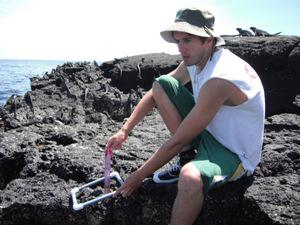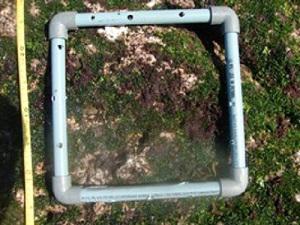John Paul Tiernan
This project will document temporal changes in the marine algal ecosystems of The Galápagos Marine Reserve, more specifically looking at changes in abundance and loss of certain species.

Grant recipient, John Paul Tiernan taking an intertidal quadrat at Cabo Douglas, Fernandina
The IUCN Red list for threatened species currently lists, of algal species found in Galápagos, ten critically endangered, four vulnerable and one endangered species. Of the ten critically endangered, the alga Bifurcaria galapagensis, which used to be highly conspicuous in the intertidal has not been recorded since 1984 and is now considered extinct together with the microhabitats it once supported. This dramatic extinction event is attributed to a failure to recover from the 1982 – 1983 El Niño event. El Niño events have also been shown to significantly alter ecosystem structure and function. Climatic perturbations such as El Niño are not the only factors affecting marine intertidal ecosystems in Galápagos. The Islands have seen their human populations rise from approximately 2,000 to over 30,000 since the early 1980s. The cascading effects of the local artisanal fisheries can lead to an increase in herbivores and a decrease in algal cover. Algal abundance strongly affects the growth and mortality rates of marine iguanas. Thus anthropogenic and climate induced changes to Galápagos intertidal ecosystems may constitute a risk both directly and indirectly to species including endemics such as the Galápagos marine iguana.

An intertidal quadrat from a mid productivity shore, Puerto Egas, Santiago
This project will make a substantial and long lasting contribution to our capacity to understand threats to species of notable conservation value such as the endemic marine iguana as mediated through the innocuous processes of indirect trophic interactions involving intertidal algal ecosystems. Endemism among Galápagos marine species is varied but generally very high for major marine groups and thus knowledge of any forcings affecting the existence and persistence of endemic species is highly desirable. Conservation threats to lesser publicised groups such as intertidal algae will also be better understood, quantified and ultimately publicised.
The capability of the Galápagos National Park Service to understand the importance of intertidal ecosystems when directing their conservation efforts in the future will be enhanced by findings emerging from this study. The future of intertidal algal surveying will be enhanced through the issuing of recommendations regarding frequency, methodology and the significance of continuity which will be factors examined in this study. This will ensure knowledge and quantification of conservation threats will be able to evolve in the future.